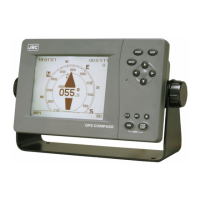2-2
2.1 SENSOR INSTALLATION
CAUTION
Do not bend the cables included with this equipment excessively, or twist them or
subject them to other strong forces. Doing so may result in damage to the
interior or exterior of the cables, and may result in fire or electrocution.
Do not install the equipment in places subject to vibration or shock.
Doing so may result in the equipment failure due to reception problems.
This equipment uses GPS satellite signals to determine the bearing of the ship.
Install the sensor where there are no impediments to electrical signal reception,
and no signal reflection. If the sensor installation location environment is
unsatisfactory, ship bearing calculations is repeatedly interrupted.
If selection of the optimal installation location is difficult, and some concessions
must be made, place the sensor in the desired installation location and test the
acceptability of the sensor results before permanently installing the sensor.
Installing the sensor in an inappropriate location may result in decreased
accuracy and equipment failure.
Whenever possible, select a place having the following characteristics.
Out of the mast's
shadow.
(2 m or more
separation)
2 m or more outside of any radar beams.
Installation near radar antennas may result in multipath wave interference, which decreases the
accuracy of the equipment.
Whenever possible, keep the equipment out of any beams.
Away from the Inmarsat antenna by at least 5 m,
and out of the scope of the beam.
An open space which
allows uniform
reception of satellite
signals.
Inmarsat antenna
redome
Radar antenna

